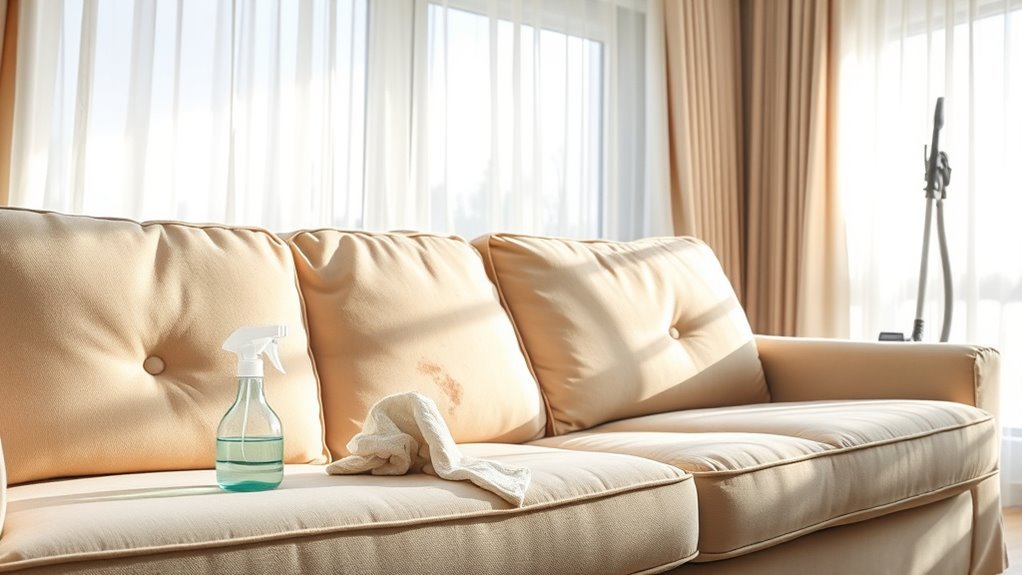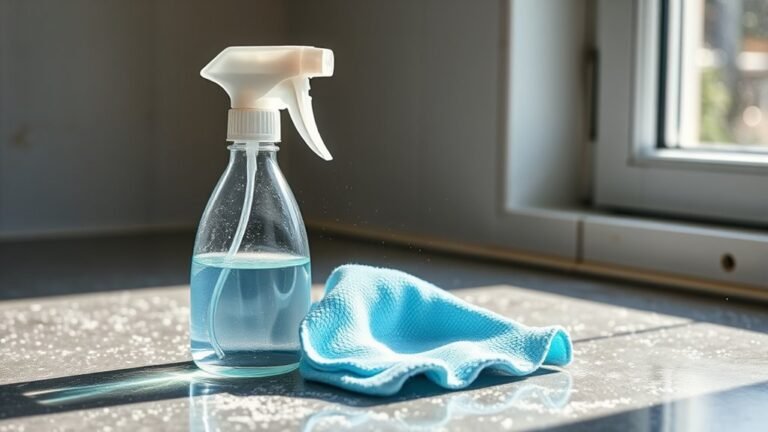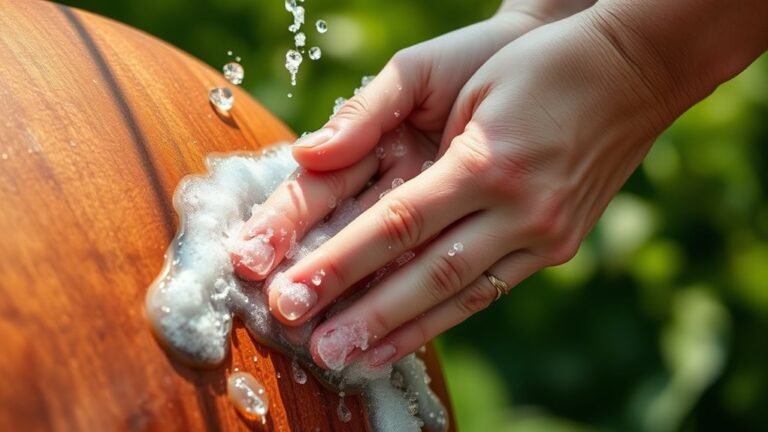Common Mistakes When Cleaning Sofa
When cleaning your sofa, avoid harsh chemicals that can damage fabric and always do a spot test first to prevent stains. Don’t soak it with water or skip drying time, or you risk mold and odors. Follow the manufacturer’s instructions carefully and don’t rub stains aggressively—blot instead. Make sure to vacuum regularly and use the right tools. Also, don’t forget cushions and crevices where dirt hides. Keep these in mind, and you’ll protect your sofa better as you explore deeper tips.
Using Harsh Chemicals That Damage Fabric
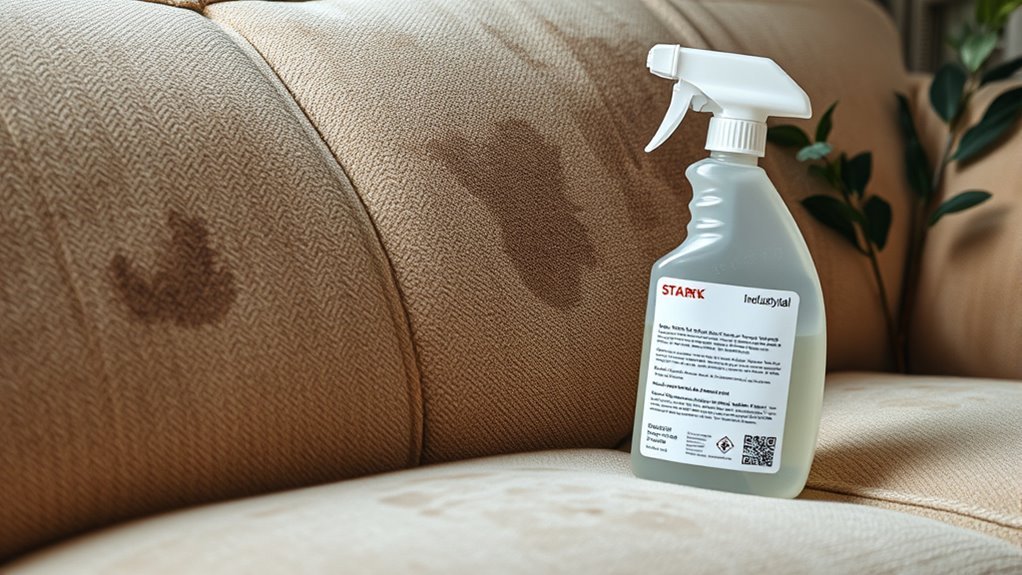
Although it might seem like a quick fix, using harsh chemicals on your sofa can actually damage the fabric. You want your furniture to last, not wear out prematurely. Instead of relying on aggressive cleaners, choose eco friendly cleaners that respect your fabric’s integrity. These products offer effective cleaning while maintaining fabric protection, letting you enjoy a fresh sofa without compromising its texture or color. By avoiding harsh chemicals, you’re also protecting your indoor environment and supporting a healthier lifestyle. Remember, true freedom in home care means using solutions that safeguard both your space and your well-being. So, opt for gentle, natural alternatives—they clean thoroughly and keep your sofa looking great longer. Your furniture deserves care that’s as thoughtful as your freedom to choose.
Skipping the Spot Test Before Cleaning
Why risk ruining your sofa when a simple spot test can save you trouble? Before diving into full cleaning, always take a moment to test fabrics discreetly. Skipping this vital step can lead to unexpected discoloration or damage, limiting your freedom to enjoy your sofa without worry. Spot cleaning a small, hidden area lets you see how your chosen cleaner interacts with the material. It’s the safest way to guarantee the fabric holds up, preventing costly mistakes. Don’t gamble with your sofa’s look—embrace the freedom that comes from knowing your cleaning approach is safe and effective. A quick spot test is your best defense against ruining your beloved furniture, so never skip it.
Over-Wetting the Sofa With Water
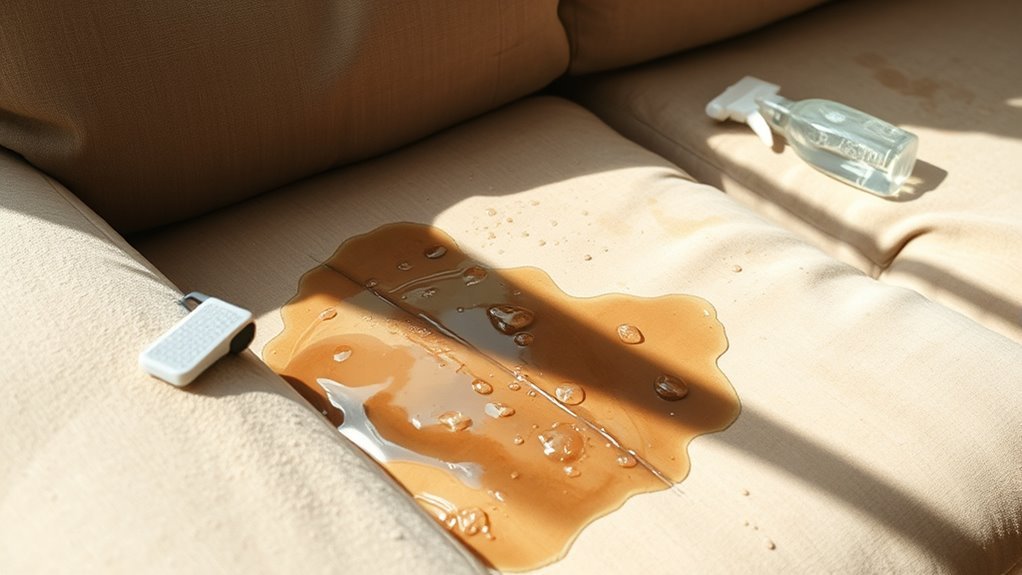
If you use too much water when cleaning your sofa, you risk damaging the fabric and causing stubborn stains or mold. Over-wetting leads to water damage that can weaken the fibers and ruin the sofa’s appearance. You want your sofa to last, so controlling the amount of moisture is key to good fabric maintenance. Instead of soaking the fabric, use a lightly damp cloth or a spray bottle with minimal water to avoid saturation. Proper drying is also essential—allow your sofa to air dry completely to prevent mold growth. Remember, less water means less risk, giving you the freedom to clean confidently without compromising your sofa’s integrity or your home’s air quality.
Ignoring Manufacturer’s Cleaning Instructions
You might be tempted to skip the label and clean your sofa however you like, but those manufacturer instructions are there for a reason. Ignoring them can lead to stains, fabric damage, or even void your warranty. Always check the cleaning guidelines to make sure you’re treating your sofa the right way.
Importance of Label Reading
A sofa’s care label holds essential cleaning instructions that you shouldn’t overlook. Understanding the label significance is key to maintaining your sofa’s fabric care without restrictions. Ignoring these guidelines can limit your freedom to clean confidently and risk damaging your furniture.
Here’s a quick guide to common care codes:
| Code | Meaning |
|---|---|
| W | Water-based cleaner |
| S | Solvent cleaner |
| WS | Water or solvent |
| X | Vacuum only |
| D | Dry clean only |
Risks of Improper Cleaning
Though it might seem harmless to skip the cleaning instructions, ignoring them can cause serious damage to your sofa’s fabric and structure. When you don’t follow the manufacturer’s guidance, you risk breaking down the fabric fibers or fading colors, undoing all efforts in stain prevention and fabric protection. You want your sofa to stay fresh and vibrant, not worn out or damaged prematurely. Using the wrong cleaner or method can leave stubborn stains or even shrink the material, limiting your freedom to enjoy your furniture. By sticking to the recommended instructions, you’re not just cleaning—you’re preserving your sofa’s life and look. Don’t let careless cleaning rob you of comfort and style you deserve.
Following Specific Fabric Guidelines
One key mistake people make is ignoring the specific cleaning guidelines for their sofa’s fabric. Each fabric type demands unique cleaning methods to keep it looking fresh and lasting longer. When you skip the manufacturer’s instructions, you risk damaging the material or losing that freedom to enjoy your sofa worry-free. Whether it’s leather, microfiber, or cotton, the right cleaning method preserves the texture and color. Don’t assume all fabrics respond well to water or harsh chemicals. Instead, take a moment to check the tags or manuals. Following these guidelines lets you clean effectively without restricting yourself, giving you the confidence to maintain your sofa’s beauty on your terms. Respecting fabric types means you’re truly in control of your cleaning routine.
Rubbing Stains Aggressively Instead of Blotting
When you spot a stain on your sofa, it might be tempting to scrub it hard, hoping to erase it quickly. But aggressive rubbing often pushes the stain deeper, making things worse. Instead, mastering blotting techniques is key to effective stain removal and preserving your sofa’s fabric.
Here’s why you should avoid rubbing:
- Rubbing spreads the stain across a wider area.
- It can damage delicate fibers, reducing your sofa’s lifespan.
- Blotting lifts the stain gently without grinding it in.
- Using a clean cloth for blotting keeps the process hygienic and efficient.
Neglecting Regular Vacuuming Before Cleaning
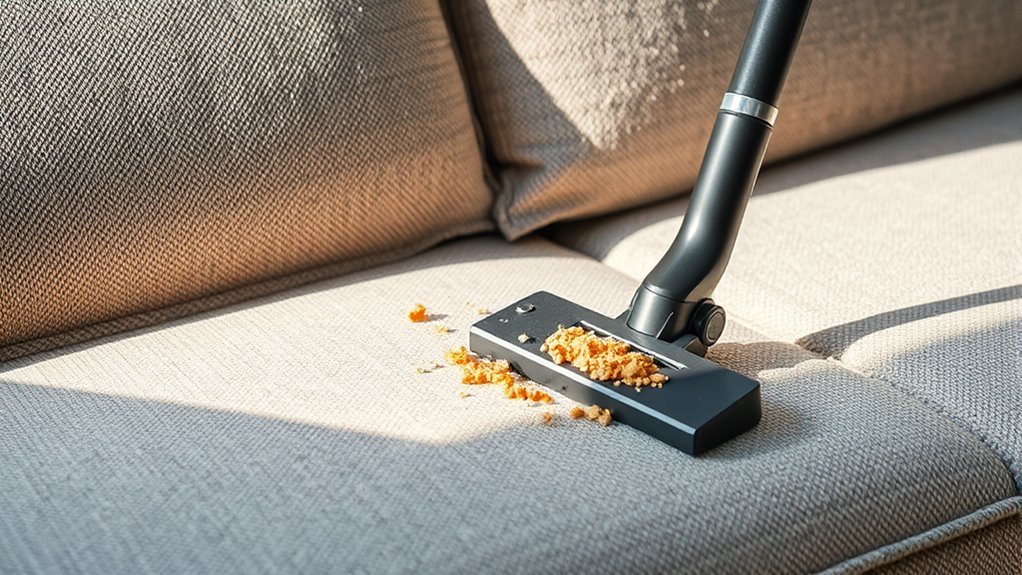
An essential step many people skip before cleaning their sofa is regular vacuuming. If you want your sofa to truly feel fresh and last longer, you can’t overlook vacuum frequency. Dust, crumbs, and pet hair settle deep into the fabric, and without removing them first, your cleaning efforts won’t be as effective. Incorporate vacuuming into your cleaning schedule—ideally once a week or more if you have pets or kids. This simple habit frees your sofa from hidden dirt and prevents buildup that can wear down fibers over time. By making vacuuming a regular part of your routine, you gain more control over cleanliness and extend your sofa’s life, giving you the freedom to relax without worrying about unseen grime.
Using the Wrong Cleaning Tools or Cloths
You might be tempted to grab any brush or cloth nearby, but using the wrong tools can damage your sofa’s fabric. Harsh or abrasive cloths can wear down the material, while inappropriate brushes might leave scratches or pull threads. It’s important to choose cleaning tools that suit your sofa’s fabric to keep it looking its best.
Choosing Inappropriate Fabric Brushes
Although it might seem minor, picking the wrong fabric brush or cleaning cloth can damage your sofa’s material. Different fabric types require specific brush materials to keep them looking fresh without wear. To avoid mistakes, consider these tips:
- Match the brush material to your sofa’s fabric type—soft bristles for delicate fabrics, stiffer ones for durable upholstery.
- Avoid brushes with metal or hard plastic bristles on sensitive fabrics; they can cause fraying or pilling.
- Use a gentle, natural fiber brush if you’re unsure about your sofa’s fabric—it’s safer and effective for most types.
- Test the brush on a hidden spot before cleaning the entire sofa to prevent unexpected damage.
Choosing the right brush gives your sofa the care it deserves, letting you enjoy freedom from worry and wear.
Using Harsh or Abrasive Cloths
Picking the right brush is only part of the care your sofa needs—using harsh or abrasive cloths can undo all that careful work. When you grab abrasive cloths, you risk damaging your sofa’s fabric types, especially delicate ones like silk or velvet. These cloths can cause pilling, scratches, or even color fading, stripping away the freedom to enjoy your sofa’s natural beauty. Instead, opt for soft, non-abrasive materials like microfiber or cotton, which clean effectively without harm. Always match your cleaning tools to your sofa’s fabric type to preserve its texture and color. Choosing gentle cloths means you won’t have to worry about wear and tear, giving you the freedom to relax on a sofa that looks fresh and feels comfortable for years.
Not Allowing Proper Drying Time After Cleaning
If you don’t let your sofa dry completely after cleaning, you risk trapping moisture that can lead to mold and unpleasant odors. Avoid moisture retention by mastering effective drying techniques. Here’s how to free your sofa from lingering dampness:
Properly drying your sofa after cleaning prevents mold and odors by eliminating trapped moisture.
- Open windows or use fans to boost air circulation around your sofa.
- Remove cushions to expose all surfaces and speed up drying.
- Avoid sitting or placing items on the sofa until it’s fully dry.
- Consider a dehumidifier in humid climates to reduce moisture in the room.
Forgetting to Clean Sofa Cushions and Crevices
Ensuring your sofa dries properly is important, but it’s equally important not to overlook cleaning the cushions and crevices. These spots often trap crumbs, dust, and allergens that can cause discomfort or damage over time. Skipping cushion cleaning means you miss out on revitalizing the parts you actually sit on most. For crevice maintenance, grab a vacuum with a narrow attachment or use a soft brush to reach deep into those hidden gaps. Regularly tackling these areas keeps your sofa feeling fresh and extends its life, giving you the freedom to relax without worry. Don’t let dirt build up where you can’t see it—make cushion cleaning and crevice maintenance part of your routine to truly care for your sofa.
Frequently Asked Questions
How Often Should I Deep Clean My Sofa?
You should aim for a deep cleaning frequency of about every six to twelve months, depending on how much you use your sofa. If you have pets or kids, more frequent cleanings might be needed. When choosing cleaning products, go for gentle, eco-friendly options that won’t harm your fabric or the environment. This way, you’ll keep your sofa fresh and enjoy the freedom of a clean, cozy space without harsh chemicals.
Can I Use Homemade Cleaning Solutions Safely?
Oh sure, just mix your own magical cleaning ingredients and watch your sofa transform into a new throne! But seriously, while homemade solutions can be tempting, their solution effectiveness varies wildly. You might free yourself from commercial products, but risk staining or damaging your sofa instead. So, if you cherish your freedom, test any concoction on a hidden spot first—because not all homemade blends are the rebels they claim to be!
What Should I Do if My Sofa Has a Strong Odor?
If your sofa has a strong odor, start with odor removal by sprinkling baking soda liberally over the fabric. Let it sit for a few hours to absorb smells, then vacuum it up. You can also use fabric fresheners designed for upholstery to keep things smelling fresh. Don’t hesitate to open windows for ventilation—fresh air is your friend. This way, you’ll enjoy a clean, inviting space without feeling tied down by harsh chemicals.
Is It Necessary to Remove Sofa Covers Before Cleaning?
Think of your sofa covers like a protective shield; removing them before cleaning often lets you tackle dirt and stains more effectively. For proper sofa maintenance, it’s usually best to take off the covers, especially if the fabric allows machine washing. This way, your cleaning techniques reach deeper layers, freeing your sofa from grime and odors. Just check the care label to know if you can wash them separately without damage.
How Do I Protect My Sofa From Future Stains?
To protect your sofa from future stains, you can use sofa protectors that act as a barrier against dirt and spills. Applying stain repellents is another great way to keep your sofa looking fresh—they create a shield that makes cleaning easier and prevents liquids from soaking in. These simple steps let you enjoy your space freely, without worrying about accidental messes ruining your comfort or style.
